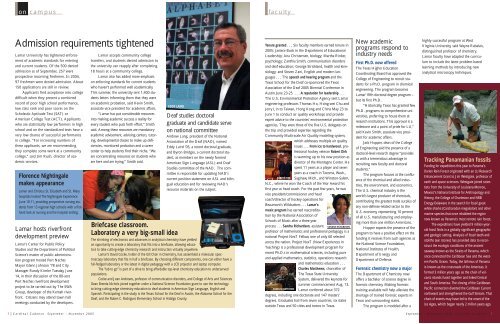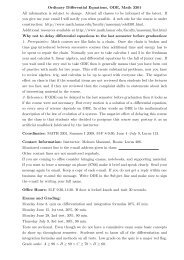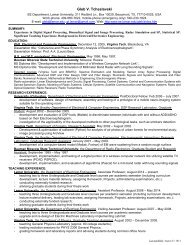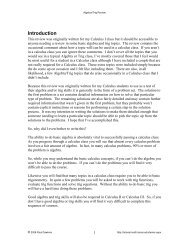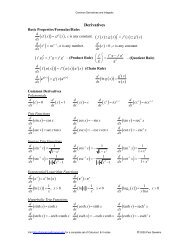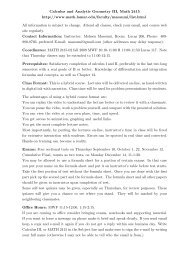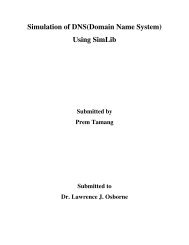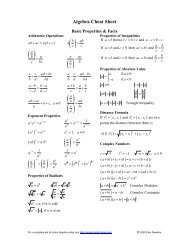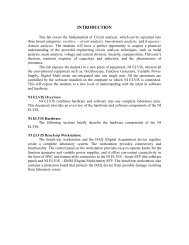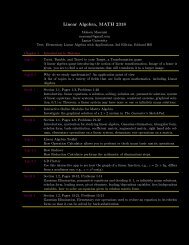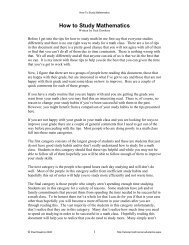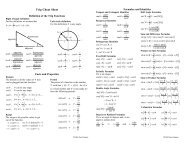Here - Lamar University
Here - Lamar University
Here - Lamar University
You also want an ePaper? Increase the reach of your titles
YUMPU automatically turns print PDFs into web optimized ePapers that Google loves.
on campusfacultyAdmission requirements tightened<strong>Lamar</strong> <strong>University</strong> has tightened enforcementof academic standards for enteringand current students. Of the 500 deniedadmission as of September, 257 wereprospective incoming freshmen. In 2004,97 freshmen were denied admission. About150 applications are still in review.Applicants find acceptance into collegedifficult when they present a combinedrecord of poor high school performance,low class rank and poor scores on theScholastic Aptitude Test (SAT) orAmerican College Test (ACT). Applicantswho are statistically low performers in highschool and on the standardized tests have avery low chance of successful performancein college. “For increasing numbers ofthese applicants, we are recommendingthey complete some work at a communitycollege,” said Jim Rush, director of academicservices.Florence Nightingalemakes appearance<strong>Lamar</strong> and Christus St. Elizabeth and St. Maryhospitals hosted The Nightingale ExperienceJune 10-11, providing prospective nursing studentsfrom 13 regional high schools with a firsthandlook at nursing and the hospital setting.<strong>Lamar</strong> hosts riverfrontdevelopment preview<strong>Lamar</strong>’s Center for Public PolicyStudies and the Department of PoliticalScience’s master of public administrationprogram hosted Port NechesMayor Glenn Johnson ’78 and CityManager Randy Kimler Tuesday, June14, in their discussion of the 80-acrePort Neches riverfront developmentproject to be carried out by The SWAGroup, developer of the Kemah riverfront.Citizens may attend town hallmeetings conducted by the developers.<strong>Lamar</strong> accepts community collegetransfers, and students denied admission tothe university can reapply after completing18 hours at a community college.<strong>Lamar</strong> also has added more emphasison enforcing standards for current studentswho haven’t performed well academically.This summer, the university sent 1,400 studentsletters informing them that they wereon academic probation, said Kevin Smith,associate vice president for academic affairs.“<strong>Lamar</strong> has put considerable resourcesinto making academic success a reality forevery student who puts forth effort,” Smithsaid. Among these resources are mandatoryacademic advisement, advising centers, tutoring,developmental classes to make up deficiencies,monitored probation and a careercenter to help students find their niche. “Weare concentrating resources on students whoare here and are trying,” Smith said.EDDY LAIRDBriefcase classroom.Laboratory a very big-small ideaDeaf studies doctoralgraduate and candidate serveon national committeeAndrew Lang, president of the NationalAssociation of the Deaf (NAD), namedEddy Laird ’05, a recent doctoral graduate,and Byron Bridges, a current doctoral student,as members on the newly formedAmerican Sign Language (ASL) and DeafStudies committee of the NAD. The committeeis responsible for updating NAD’scurrent position statement on ASL and bilingualeducation and for reviewing NAD’sresource materials on the subject.The shrinking of electronics and advances in analytical chemistry have yieldedan opportunity to create a laboratory that fits into a briefcase, allowing educatorsto take cutting-edge chemistry research and instruction virtually anywhere.<strong>Lamar</strong>’s David Cocke, holder of the Gill Chair in Chemistry, has assembled a molecular spectroscopylaboratory that fits in half a briefcase. By choosing different components, one can either have afull-fledged laboratory or the latest in digital pedagogy with a LCD projector and laptop computer.The “lab to go” is part of a drive to bring affordable top-level chemistry education to underservedpopulations.Cocke and Jean Andrews, professor of communication disorders, and College of Arts and SciencesDean Brenda Nichols joined together under a National Science Foundation grant to use the technologyto bring cutting-edge chemistry education to deaf students in American Sign Language, English andSpanish. Participating in the study is the Texas School for the Deaf in Austin, the Alabama School for theDeaf, and the Ruben C. Rodriguez Elementary School in Hidalgo County.Tenure granted . . . Six faculty members earned tenure in2005: Janiece Buck in the Department of EducationalLeadership; Ana Christensen, biology; Martha Rinker,psychology; Zanthia Smith, communication disordersand deaf education; George Strickland, health and kinesiology;and Steven Zani, English and modern languages. . . The speech and hearing program and theTexas School for the Deaf co-sponsored the TexasAssociation of the Deaf 2005 Biennial Conference inAustin June 23-25 . . . A reputation for leadership . . .The U.S. Environmental Protection Agency sent <strong>Lamar</strong>engineering professors Thomas Ho, Hsing-wei Chu andJerry Lin to Taiwan, Hong Kong and China May 23 toJune 1 to conduct air quality workshops and provideexpert advice to the countries’ environmental protectionagencies. They were three of the five U.S. delegates onthe trip and provided expertise regarding theCommunity Multi-scale Air Quality modeling system,which addresses multiple air qualityissues . . . From ice to hardwood, professionalhockey veteran Robert Dirkis warming up to his new position asdirector of the Montagne Center. Hespent 11 years as a player and sevenyears as a coach in Tacoma, Wash.,ROBERT DIRK Saginaw, Mich., and Winston-Salem,N.C., where he won the Coach of the Year Award hisfirst year as head coach. For the past few years, he wasvice president/commissioner and headcoach/director of hockey operations forBeaumont’s Wildcatters . . . <strong>Lamar</strong>’smusic program has earned reaccreditationby the National Association ofSchools of Music after a three-yearprocess . . . Sandra Richardson, assistant SANDRA RICHARDSONprofessor of mathematics and professional pedagogy, is anational Project NexT Fellow, one of only 60 selectedacross the nation. Project NexT (New Experiences inTeaching) is a professional development program forrecent Ph.D.s in mathematical sciences, including pureand applied mathematics, statistics, operations researchand mathematics education . . .Charles Matthews, chancellor ofThe Texas State <strong>University</strong>System, delivered the keynote forsummer commencement Aug. 13.CHARLES MATTHEWS<strong>Lamar</strong> conferred about 372degrees, including one doctorate and 147 masters’degrees. Graduates hail from seven countries, six statesoutside Texas and 50 cities and towns in Texas.New academicprograms respond toindustry needsFirst Ph.D. now offeredThe Texas Higher EducationCoordinating Board has approved theCollege of Engineering to recruit studentsfor a Ph.D. program in chemicalengineering. The program becomes<strong>Lamar</strong>’ fifth doctoral degree program –but its first Ph.D.“Historically, Texas has granted fewPh.D. programs to comprehensive universities,preferring to house them atresearch institutions. This approval is amilestone and a point of pride for LU,”said Kevin Smith, associate vice presidentfor academic affairs.Jack Hopper, dean of the Collegeof Engineering said the presence of adoctoral-level research degree “providesus with a tremendous advantage inrecruiting new faculty and doctoralstudents.”The program focuses at the confluenceof the chemical and allied industries,the environment, and economics.The U.S. chemical industry is theworld’s largest producer of chemicals,contributing the greatest trade surplus ofany non-defense-related sector to theU.S. economy, representing 10 percentof all U.S. manufacturing and employingmore than one million Americans.Hopper expects the presence of theprogram to have a positive effect on thefunding it receives from such agencies asthe National Science Foundation,National Institutes of Health,Department of Energy andDepartment of Defense.Forensic chemistry now a majorThe Department of Chemistry nowoffers a bachelor of science degree inforensic chemistry. Making forensictraining available will help alleviate theshortage of trained forensic experts inTexas and surrounding states.The program is modeled after ahighly successful program at WestVirginia <strong>University</strong>, said Wayne Rabalais,distinguished professor of chemistry.<strong>Lamar</strong> faculty have adapted the curriculumto include the latest problem-basedlearning methods by introducing newanalytical microscopy techniques.Tracking Panamanian fossilsFunding for expeditions this year to Panama’sDarien Rain Forest originated with an LU ResearchEnhancement Grant to Jim Westgate, professor ofearth and space sciences. Westgate joined scientistsfrom the <strong>University</strong> of Louisiana-Monroe,Mexico’s National Institute for Anthropology andHistory, the College of Charleston and NRBEnergy-Delaware in the search for fossil greatwhite sharks (Carcharodon megalodon) and othermarine species that once inhabited the regionnow known as Panama’s most remote rain forest.The expeditions have yielded 9 million-yearoldfossil finds in a globally significant geographicand geologic setting. Analysis of fossil teeth andotoliths (ear stones) has provided data to reconstructthe ecologic conditions of the ancientseaway known as the Straits of Panama, whichonce connected the Caribbean Sea and the westernPacific Ocean. Today, the Isthmus of Panamais known as the crossroads of the Americas. Itformed 3 million years ago as the chain of volcanicislands fused together and linked Centraland South America. The closing of the Caribbean-Pacific connection diverted the Caribbean Currentnorthward and strengthened the Gulf Stream. Thatchain of events may have led to the onset of theIce Ages, which began nearly 2 million years ago.4 | Cardinal Cadence September - November 2005September - November 2005 Cardinal Cadence | 5


